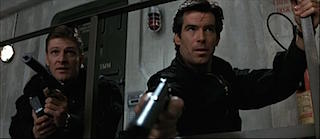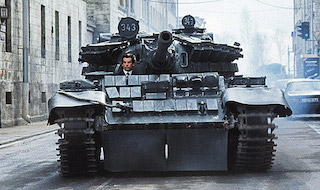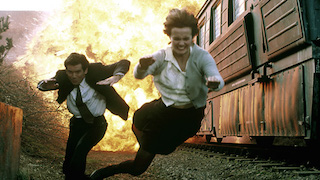“You don’t like me, Bond.” Judi Dench, the new head of MI6 and first female to play the role of M, gets right in the face of Pierce Brosnan, the new James Bond.
“The thought had crossed my mind,” Bond smugly admits.
“Good, because I think you’re a sexist, misogynist dinosaur. A relic of the Cold War, whose boyish charms, though wasted on me, obviously appealed to that young woman I sent out to evaluate you.” Shots fired, Judi Dench!
Within the first thirty minutes of Goldeneye, the seventeenth installment in the Bond franchise and the first with Pierce Brosnan as James Bond, the producers and writers want you to know that you are not getting the same old James Bond of the previous sixteen movies. In fact, this is also the first movie to not utilize any story elements from Ian Fleming’s writings. The only intact elements are the characters, motifs, and artifacts that make up 007. However, the movie title is an homage to Fleming; an operation from his time serving in World War II was named Goldeneye and he also used it as the name of his estate where he wrote the Bond novels.
As always, the cold open of Goldeneye is exciting and kicks off the movie with bravado and style. It mixes old elements, such as clever quips, grand entrances, and resourceful escapes, with newer, more modern filmmaking elements reminiscent of pre-Matrix action movies. The title music hits from Tina Turner and there is great optimism we’ve got a retro nouveau Bond.
007 is tasked with tracking down the whereabouts of a suspected member of the Janus crime syndicate, the deadly yet gorgeous Xenia Onatopp (Famke Janssen), an assassin with a euphoric lust for murder. After she evades his grasp in Monte Carlo, MI6 tracks her and an associate, General Ourumov, to Severnaya, Siberia, Russia where an odd EMP blast alerts the British agency to the possible existence of a Russian superweapon now being in the hands of Janus. His next task is to head to Russia to track down the one remaining survivor of the Severnaya EMP blast, Natalya Simonova (Izabella Scorupco), and find a way to disable the weapon before it is used again. What 007 isn’t prepared for is to meet an old friend and agent, Alec Trevelyan (Sean Bean), who was presumed dead after the opening sequence but is the secret head of the Janus crime syndicate. Bond and Natalya have to track Trevelyan to Havana, Cuba in order to stop Goldeneye from being used to destroy London.
What is quite fascinating about Goldeneye is how much it reads like a Bond film, but what is on screen feels like something completely different. Sure, all the elements are there, and yet the spy-like elements of the movie are severely downplayed in favor of a more Willis/Schwarzenegger-style action movie. The mood of “relics of the Cold War” pervades 007’s use of the gadgets. It’s all extremely matter-of-fact and it doesn’t have the fun and quirk of previous Bond films. It’s much more self-serious. There are tons of explosions, some that don’t even make sense. Bond rakes his machine gun across the screen and the body count piles up. He’s not a ruthless killer of individuals, but a McClain/Harry Tasker super soldier that feels a tad out of place in a Bond movie. I half expected Brosnan to try his best Brit-inflected, “Yippee Ki Yay,” after one particularly narrow, bullet-dodging escape. Heck, Bond rides in a tank through the streets of St. Petersburg, for crying out loud!
 However, in the quieter moments of the film, Brosnan shines. What he lacks in action-hero chops he makes up for with a handsome face and charisma. He is not Connery’s brand of oozing machismo, but a more subtle, affable charm. M’s criticism of him as a misogynist dinosaur seems directed at a non-Brosnan Bond archetype. He’s a much softer, gentler Bond; prone not to creature comfort weaknesses but an honor and heart committed to duty. His encounters with Trevelyan and Natalya open a new part of his heart that is open to debate why he does everything, “For England.” His final line to his former MI6 colleague exposes how conflicted he might be. Trevelyan, at James’ mercy, asks him, “For England, James?” He responds, “No, for me.”
However, in the quieter moments of the film, Brosnan shines. What he lacks in action-hero chops he makes up for with a handsome face and charisma. He is not Connery’s brand of oozing machismo, but a more subtle, affable charm. M’s criticism of him as a misogynist dinosaur seems directed at a non-Brosnan Bond archetype. He’s a much softer, gentler Bond; prone not to creature comfort weaknesses but an honor and heart committed to duty. His encounters with Trevelyan and Natalya open a new part of his heart that is open to debate why he does everything, “For England.” His final line to his former MI6 colleague exposes how conflicted he might be. Trevelyan, at James’ mercy, asks him, “For England, James?” He responds, “No, for me.”
Likewise, Natalya has harsh words from him before the final mission. She essentially delivers the, “you suck because you care about your job too much,” speech and puts salt in the wound when he responds, “that is how I stay alive,” and she quickly corrects him, “that is how you stay alone.” Having re-watched this on the heels of Goldfinger, it is a startling indictment of Bond as portrayed by Connery and certainly something you wouldn’t expect from a “Bond girl.” Although Scorupco’s performance is suspect at times, especially when she is scolding the “boys and their toys,” this scene is sensitive and well done. While she is not there to fight, only to be the typical 90’s action movie tag along, she has fire and a moxie that could have done her well if anyone other than Moneypenny was a reoccurring character.
The elements of 90’s action, something we look on with particular irony as we wound down our less cynical, less fearful, and more Cold War-like, pre-9/11 view of international conflict, is by far the most difficult aspect to swallow in these movies. The movie never gets around to fleshing out if he really is a relic and dinosaur. We still wanted the same thing in out heroes in the 1990’s, but we wanted more bravado, more explosions, and lots of helicopters. So…many…helicopters.
The sad reality of Goldeneye and all the Pierce Brosnan helmed Bond movies, is that they are stuck in the transitional period from one type of hero to the next. Two years after this movie, Mike Meyers would pan/honor Bond films with the hilarious Austin Powers: International Man of Mystery. Meyers’ spoof of the films certainly can read as a prescient commentary on the clash of values between what James Bond was/is and what modern culture is. The old values, old ways, and old tropes were now nothing more than a cultural artifact we tend to look back at with some fondness, some revulsion, but mostly whimsy and a snicker. What is amazing is Goldeneye was still keen on keeping one foot treading the old Bond path and trying to forge a new path with this movie. The problem was essentially Frostian. The filmmakers should have taken the path less traveled and it would have made all the difference.

